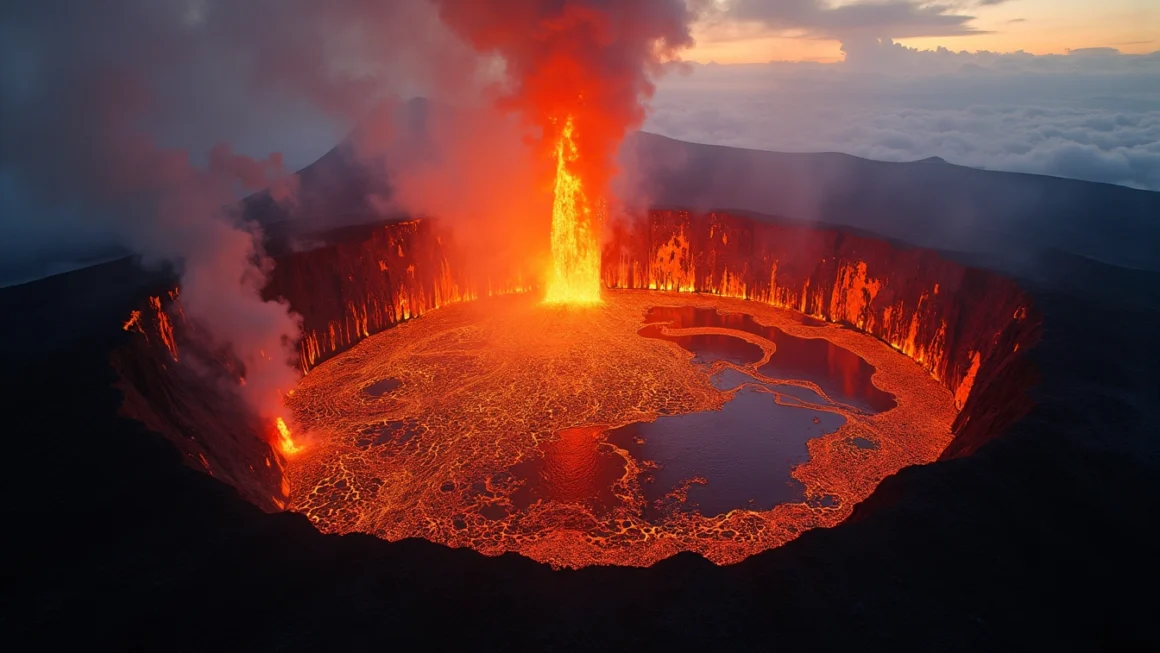On December 27, 2024, at approximately 3:15 p.m. HST, the USGS Hawaiian Volcano Observatory (HVO) detected seismic activity indicating the onset of a new eruption at Kīlauea’s summit within Halemaʻumaʻu crater. This latest volcanic event marks another chapter in the ongoing geological saga of one of Hawaii’s most active volcanoes.
The Eruption Begins
Table of Contents
Within minutes of the initial seismic detection, HVO staff observed lava fountains emerging from the western wall of Halemaʻumaʻu crater. These fountains quickly grew in intensity, reaching heights of up to 50 meters (164 feet). The spectacle was both awe-inspiring and scientifically significant, providing researchers with valuable data on the volcano’s behavior.
Rapid Development and Spread
As the eruption progressed, multiple fissures opened along the crater floor, releasing streams of molten lava. These fissures, spanning approximately 1 kilometer (0.6 miles) in length, created a mesmerizing display of nature’s raw power. The lava flows rapidly began to fill the crater floor, creating a dynamic and ever-changing landscape.
Lava Lake Formation
One of the most notable developments was the formation of a new lava lake within Halemaʻumaʻu. This molten pool grew quickly, fed by the continuous influx of lava from the active fissures. The lake’s surface was a roiling mass of incandescent rock, offering scientists a unique opportunity to study lava dynamics in real-time.
Monitoring and Safety Measures
The USGS HVO, in collaboration with Hawaii Volcanoes National Park officials, immediately implemented enhanced monitoring protocols. These measures included:
- Continuous seismic monitoring to track underground magma movements
- Gas emission measurements to assess potential air quality impacts
- Thermal imaging to map the extent and temperature of lava flows
- Drone surveys to capture aerial imagery and data
Public safety remained a top priority, with park officials closing certain areas to visitors and implementing strict viewing guidelines. While the eruption posed no immediate threat to populated areas, authorities remained vigilant, ready to respond to any changes in volcanic activity.
Scientific Significance
This eruption provides volcanologists with a wealth of data to further our understanding of Kīlauea’s behavior. By studying the patterns of fissure openings, lava fountain dynamics, and the formation of the lava lake, scientists can refine their models of volcanic processes. This knowledge is crucial for improving eruption forecasting and risk assessment not just for Kīlauea, but for similar volcanoes worldwide.
Technological Advancements in Monitoring
The 2024 eruption also showcases the advancements in volcanic monitoring technology. High-resolution cameras, satellite imagery, and advanced seismic networks allow for unprecedented real-time observation and analysis. These tools enable scientists to make more accurate predictions and provide timely information to the public and emergency management agencies.
Environmental and Cultural Impact
While the eruption is a spectacular natural phenomenon, it also has significant environmental and cultural implications. The release of volcanic gases, primarily water vapor, carbon dioxide, and sulfur dioxide, can affect local air quality and potentially impact nearby ecosystems. However, these emissions also play a role in the natural cycles that have shaped Hawaii’s unique environment over millions of years.
Culturally, Kīlauea holds immense significance for Native Hawaiians. The volcano is believed to be the home of Pele, the goddess of fire and volcanoes. Many view the eruption as a manifestation of Pele’s power and presence, adding a deep spiritual dimension to the scientific observations.
Looking Ahead
As the eruption continues, scientists and officials remain focused on monitoring its progress and potential impacts. The duration and ultimate extent of this volcanic event remain uncertain, as Kīlauea has shown highly variable eruption patterns in the past. Researchers will continue to analyze data and update their models, providing valuable insights into volcanic behavior and improving our ability to coexist with these powerful natural forces.
For those interested in exploring how technology and automation can assist in natural disaster monitoring and response, advanced automation platforms offer innovative solutions for data integration and emergency management systems.
Conclusion
The December 27, 2024 eruption of Kīlauea serves as a powerful reminder of the dynamic nature of our planet. It offers a unique opportunity for scientific study, cultural reflection, and appreciation of the raw beauty of volcanic processes. As we continue to observe and learn from this event, it underscores the importance of ongoing research, preparedness, and respect for the natural world that shapes our islands and our understanding of Earth’s geological processes.




